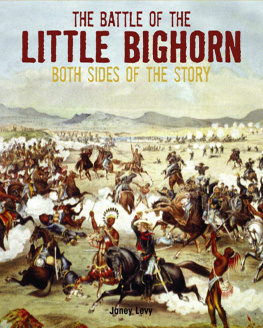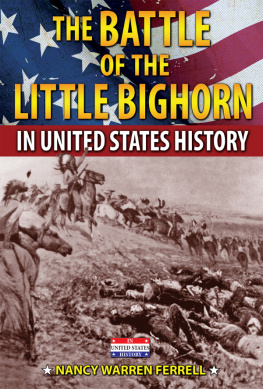The Battle of the Greasy Grass/Little Bighorn
In June of 1876, the U.S. governments plan to pressure the Lakota and Cheyenne people onto reservations came to a dramatic and violent end with a battle that would become enshrined in American memory. In the eyes of many Americans at the time, the battle of Little Bighorn represented a symbolic struggle between the civil and the savage. Known as the Battle of the Greasy Grass to the Lakota, the Battle of the Little Bighorn to the people who suppressed them, and as Custers Last Stand in the annals of popular culture, the event continues to captivate students of American history.
In The Battle of the Greasy Grass/Little Bighorn, Debra Buchholtz narrates the history of the battle and critically examines the legacy it has left. In five concise chapters, bolstered by government documents, newspaper articles, and eyewitness accounts, Buchholtz shows how the battle continues to shape the way we understand indigenous peoples, the Wild West, and the history of America.
For additional documents, images, and resources please visit The Battle of the Greasy Grass/Little Bighorn companion website at:
www.routledge.com/cw/criticalmoments
Debra Buchholtz is a lecturer in the Geography and Anthropology department at California State Polytechnic University
Critical Moments in American History
Edited by William Thomas Allison
The Assassination of John F. Kennedy
Political Trauma and American Memory
Alice L. George
The Battle of the Greasy Grass/Little Bighorn
Custers Last Stand in Memory, History, and Popular Culture
Debra Buchholtz
The Battle of the Greasy Grass/Little Bighorn
Custers Last Stand in Memory, History, and Popular Culture
Debra Buchholtz
First published 2012
by Routledge
711 Third Avenue, New York, NY 10017
Simultaneously published in the UK
by Routledge
2 Park Square, Milton Park, Abingdon, Oxon OX14 4RN
Routledge is an imprint of the Taylor & Francis Group, an informa business
2012 Taylor & Francis
The right of Debra Buchholtz to be identified as the author of this work has been asserted in accordance with sections 77 and 78 of the Copyright, Designs and Patents Act 1988.
All rights reserved. No part of this book may be reprinted or reproduced or utilized in any form or by any electronic, mechanical, or other means, now known or hereafter invented, including photocopying and recording, or in any information storage or retrieval system, without permission in writing from the publishers.
Trademark notice: Product or corporate names may be trademarks or registered trademarks, and are used only for identification and explanation without intent to infringe.
Library of Congress Cataloging in Publication Data
Buchholtz, Debra.
The battle of the Greasy Grass / Little Bighorn : Custers last stand in memory, history, and popular culture / by Debra Buchholtz.
p. cm.
Includes bibliographical references and index.
1. Little Bighorn, Battle of the, Mont., 1876. 2. Cheyenne IndiansWars, 1876. 3. Dakota IndiansWars, 1876. 4. Indians in popular culture. 5. Indians of North AmericaPublic opinion. 6. Custer, George A. (George Armstrong), 18391876Public opinion. 7. Public opinionUnited States. I. Title.
E83.876.B93 2012
973.82dc23
ISBN: 978-0-41589558-3 (hbk)
ISBN: 978-0-41589559-0 (pbk)
ISBN: 978-0-20311678-4 (ebk)
Typeset in Bembo and Helvetica Neue by Florence Production Ltd, Stoodleigh, Devon
Contents
Welcome to the Routledge Critical Moments in American History series. The purpose of this new series is to give students a window into the historians craft through concise, readable books by leading scholars, who bring together the best scholarship and engaging primary sources to explore a critical moment in the American past. In discovering the principal points of the story in these books, gaining a sense of historiography, following a fresh trail of primary documents, and exploring suggested readings, students can then set out on their own journey, to debate the ideas presented, interpret primary sources, and reach their own conclusions just like the historian.
A critical moment in history can be a range of things a pivotal year, the pinnacle of a movement or trend, or an important event such as the passage of a piece of legislation, an election, a court decision, a battle. It can be social, cultural, political, or economic. It can be heroic or tragic. Whatever they are, such moments are by definition game changers, momentous changes in the pattern of the American fabric, paradigm shifts in the American experience. Many of the critical moments explored in this series are familiar; some less so.
There is no ultimate list of critical moments in American history any group of students, historians, or other scholars may come up with a different catalog of topics. These differences of view, however, are what makes history itself and the study of history so important and so fascinating. Therein can be found the utility of historical inquiry to explore, to challenge, to understand, and to realize the legacy of the past through its influence of the present. It is the hope of this series to help students realize this intrinsic value of our past and of studying our past.
William Thomas Allison
Georgia Southern University
This volume incorporates results from research conducted in archives around the United States and on or near the Little Bighorn Battlefield National Monument. Funding was generously provided by the University of Minnesota Graduate School and Department of Anthropology, the American Philosophical Societys Phillips Fund for Native American Research, the Autry Institute for the Study of the American West at the Autry Museum of Western Heritage, and The British Academy.
A special word of thanks is due to the many residents of and visitors to the Greasy Grass/Little Bighorn area who graciously shared their thoughts with me and answered my seemingly endless questions. National Park Service staff at the Little Bighorn Battlefield National Monument and the Harpers Ferry Center have gone out of their way to be of assistance, often at relatively short notice. Many thanks to them and to the knowledgeable and always helpful Magdalene Medicine Horse Moccasin, former archivist at the Little Big Horn College Archives.
1803 | Louisiana Purchase |
18041806 | Lewis and Clark Expedition |
1851 | First Fort Laramie Treaty |
18611865 | Civil War |
1862 | Santee Sioux (Minnesota) Uprising |
November 29, 1864 | Sand Creek Massacre |
1866 | Custer and the 7th Cavalry posted to Fort Riley, Kansas |
18661868 | Red Clouds War |
1868 | Second Fort Laramie Treaty |
November 27, 1868 | Battle of the Washita |
1873 | Panic of 1873 and recession |
1873 | Custer and the 7th Cavalry posted to Ft. Abraham Lincoln, Dakota Territory |




